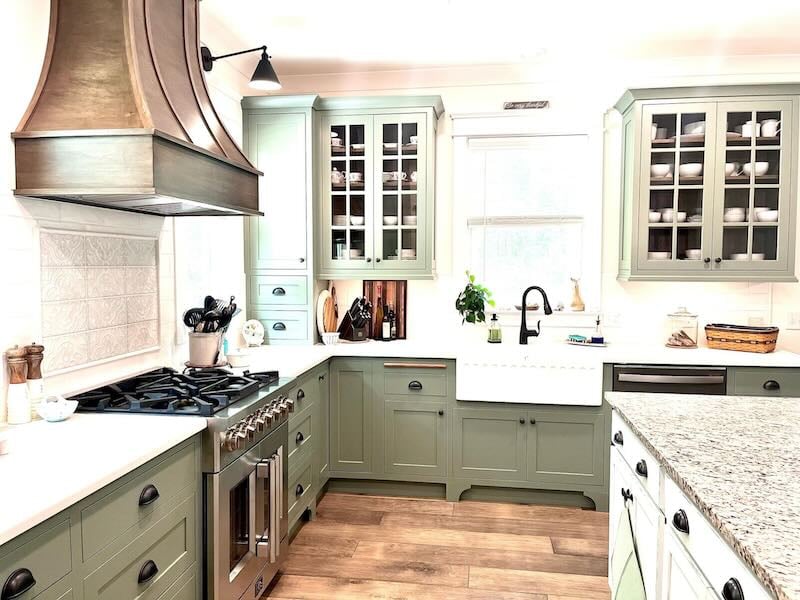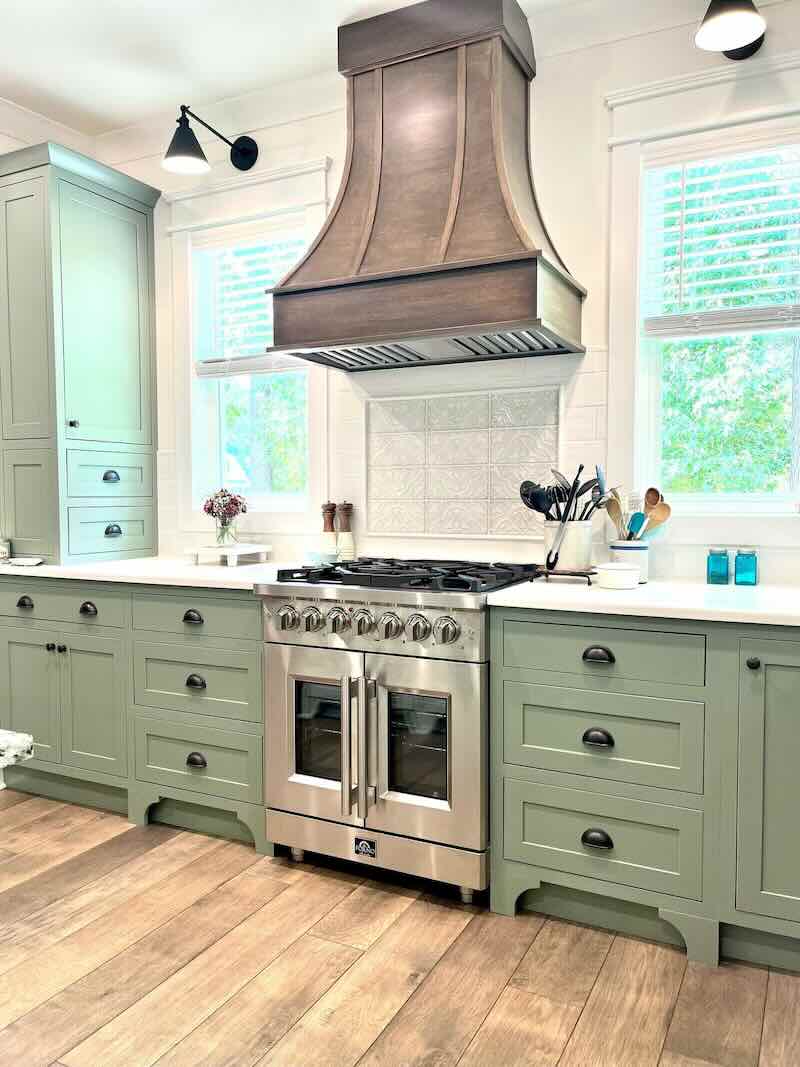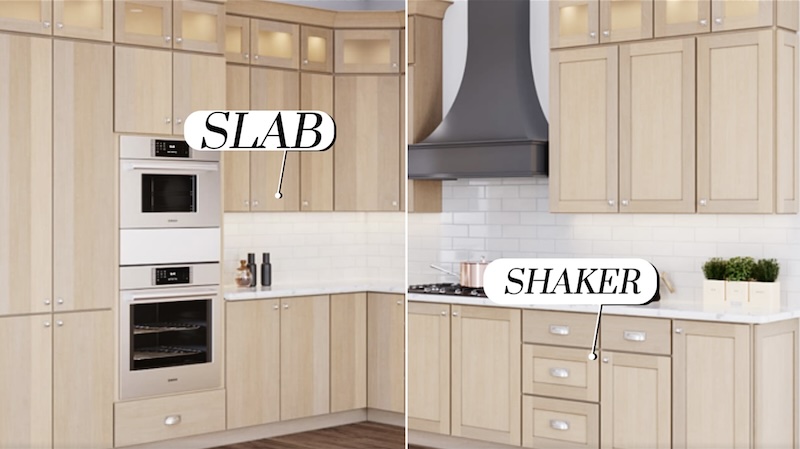Slab vs Shaker Cabinets: Style, Cost, and Durability Compared
by Gary Wade • September 26, 2024
The main difference between slab vs. shaker cabinets is the design of the door. Slab cabinets have a flat, smooth surface with little or no detailing on the doors , giving them a modern, minimalist look. Shaker cabinets, on the other hand, feature a recessed center panel framed by a flat border, offering a more classic, versatile style that blends traditional and contemporary aesthetics. Slab cabinets are often chosen for sleek, streamlined spaces, while shaker cabinets are popular for their simple yet elegant craftsmanship.
When it comes to kitchen design, the choice between slab and shaker cabinets can make a world of difference. These two popular styles have distinct characteristics that influence not only the look of a kitchen but also its functionality and cost. Homeowners and designers often find themselves weighing the merits of slab style kitchen cabinets against the timeless appeal of Shaker cabinets, each offering unique advantages in terms of esthetics and practicality.
This article dives deep into the slab vs shaker cabinets debate, exploring their design elements, cost implications, and durability factors. Readers will gain insights into the style versatility of both options, understand the installation process, and learn about their impact on resale value. Additionally, the piece breaks down the pros and cons of slab panel kitchen cabinets and Shaker cabinets, helping homeowners make an informed decision that aligns with their taste, budget, and long-term kitchen goals.

Design and Esthetics
Slab and shaker cabinets offer distinct design esthetics that cater to different tastes and interior styles. Slab cabinets, characterized by their flat, smooth surfaces, bring a sleek and minimalist look to kitchens. These cabinets feature a single panel with no ornate detailing, making them ideal for modern and contemporary spaces.
On the other hand, shaker cabinets boast a timeless appeal with their five-piece door construction, featuring a recessed center panel framed by four pieces similar to a picture frame but without the mitered corners This classic design has made shaker cabinets a versatile choice, suitable for both traditional and contemporary settings. The clean lines of both styles allow for easy customization with various colors, finishes, and hardware options to suit individual preferences.
Cost Comparison
The cost of slab vs shaker cabinets varies depending on several factors. Shaker cabinets generally come with a higher price tag due to their craftsmanship and customization options. However, they're widely available and can be affordable for budget-conscious homeowners.
Slab cabinets, with their simpler design, often offer a more cost-effective solution without compromising style. The pricing difference also depends on materials used - solid wood slabs can be pricier than plywood shaker panels. Ultimately, factors like finish, location, and specific design requirements play crucial roles in determining the final cost of both cabinet styles.

Durability and Maintenance
Both slab and shaker cabinets offer durability when constructed with high-quality materials. Shaker cabinets are known for their solid construction and resistance to wear and tear. Slab cabinets, with their smooth surfaces, are easier to clean as they lack nooks where dirt can accumulate. While shaker cabinets may require more frequent dusting due to their design, they're still straightforward to maintain. A damp cloth is usually sufficient for cleaning both styles.
For busy families, slab cabinets might be preferable due to their low-maintenance nature, but shaker cabinets remain a popular choice for their timeless appeal and sturdy build.
Style Versatility
Shaker cabinets shine in their remarkable adaptability, seamlessly fitting into various kitchen designs. Their clean lines and simple elegance make them a chameleon-like choice, equally at home in traditional, contemporary, or transitional settings. Homeowners and designers appreciate the flexibility to customize shaker cabinets with different finishes, hardware, and accessories, allowing for a personalized touch that complements any esthetic preference.
Slab cabinets, with their sleek and modern appearance, offer a minimalist appeal that works well in contemporary spaces. Their smooth, uninterrupted surfaces provide a clean canvas for other design elements to stand out. This versatility makes slab cabinets an excellent choice for those seeking a modern look or wanting to highlight other architectural features in their kitchen.
Both styles can be easily updated to reflect changing tastes, ensuring longevity in home design. Whether opting for the timeless charm of shaker cabinets or the sleek modernity of slab cabinets, homeowners can create a kitchen that perfectly aligns with their vision and lifestyle.
Resale Value and Longevity
When considering kitchen cabinets, homeowners often weigh the impact on resale value. Shaker cabinets have proven to be a timeless choice, appealing to a wide range of potential buyers. Their classic design and versatility make them a safe bet for those planning to sell within five years. Slab cabinets, while modern and sleek, may have a more limited appeal in traditional markets. However, both styles can add value when crafted from high-quality materials.
For longevity, Shaker cabinets have stood the test of time, remaining popular for centuries due to their durability and adaptable esthetic. Ultimately, the choice between slab and Shaker may depend on the overall style of the home and local market preferences.

Pros and Cons Overview
Slab cabinets offer a sleek, modern look with smooth surfaces that are easy to clean. They're generally more cost-effective and require less maintenance. However, their minimalist design may limit versatility in traditional settings.
Shaker cabinets, on the other hand, boast timeless appeal and versatility, complementing both traditional and contemporary styles. They're known for durability and easy maintenance, but come at a higher price point. Shaker designs also require more frequent dusting due to their recessed panels.
Ultimately, the choice between slab and shaker depends on personal style preferences, budget constraints, and long-term design goals.
Slab or Shaker Kitchen Cabinets?
The choice between slab and shaker cabinets has a big impact on the overall look and feel of a kitchen. Both styles have their own strengths, with slab cabinets offering a sleek, modern appearance and easy maintenance, while shaker cabinets bring timeless appeal and versatility to various design settings. The decision ultimately depends on personal taste, budget constraints, and long-term goals for the space.
When weighing these options, homeowners should think about factors like cost, durability, and resale value. Slab cabinets often provide a more budget-friendly solution, while shaker cabinets might be a safer bet for long-term appeal. In the end, both styles can create stunning kitchens when chosen thoughtfully and paired with complementary design elements. The key is to pick the option that best fits your lifestyle and vision for your home.

Thinking slab or shaker kitchen cabinets but not sure? Contact us and we’ll be happy to help you decide.
FAQs
How durable are Shaker cabinets?
Shaker cabinets are made from high-quality hardwood, which ensures their sturdiness and longevity. Their design is well-suited to withstand the demands of a busy kitchen, making them a valuable investment.
Are flat panel cabinets more affordable than Shaker cabinets?
Yes and no, flat-panel cabinets can be more budget-friendly compared to Shaker cabinets, which are generally more expensive due to their detailed construction but solid wood slab design generally even out the difference and can sometimes carry an even higher cost.
What style of cabinets is generally the most affordable?
Flat slab cabinets, and to some extent, Shaker cabinets, are typically on the lower end of the price spectrum due to their simpler door design. In contrast, more intricate styles like glass panel cabinets, raised panels or mitered styles can be considerably more expensive.
overall rating: my rating: log in to rate




